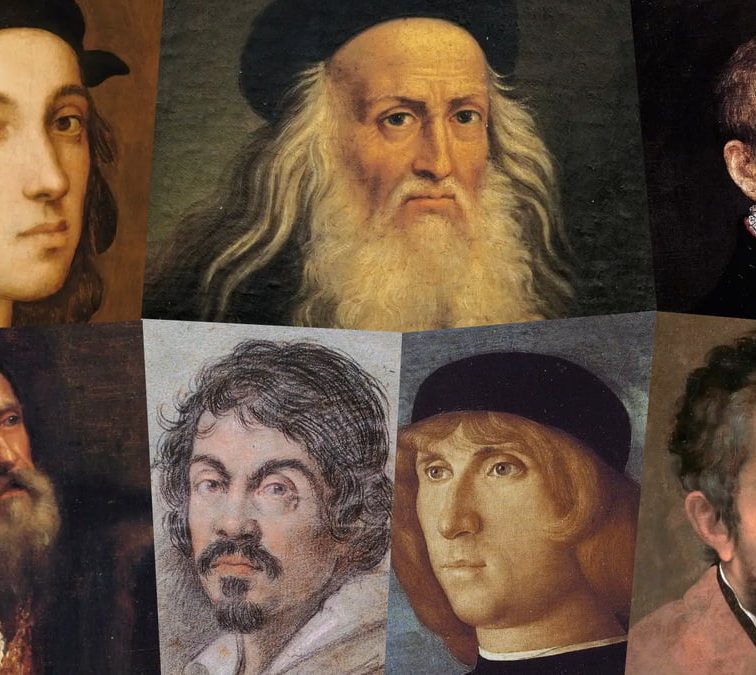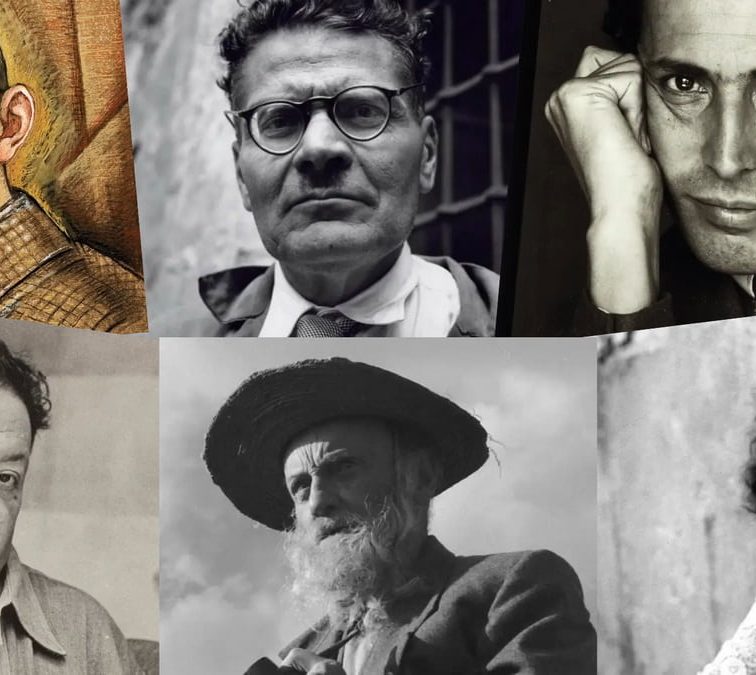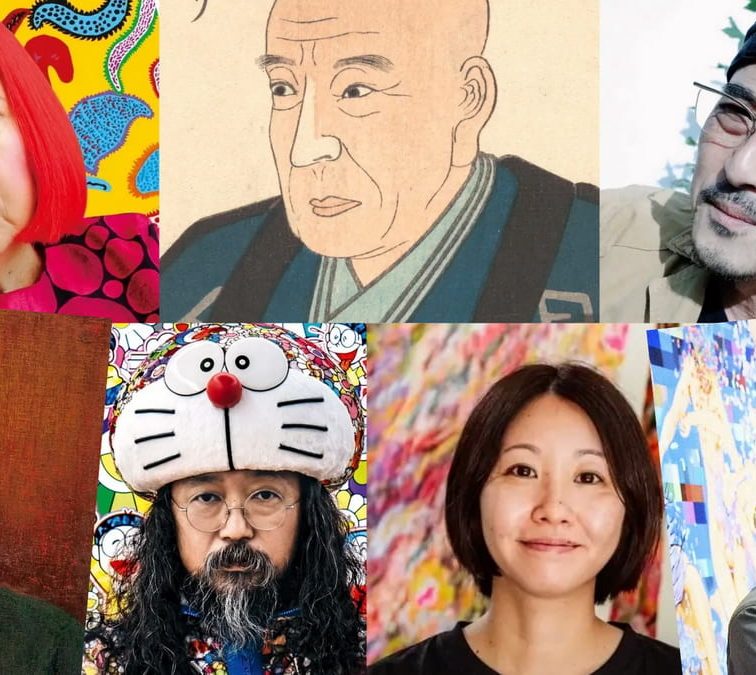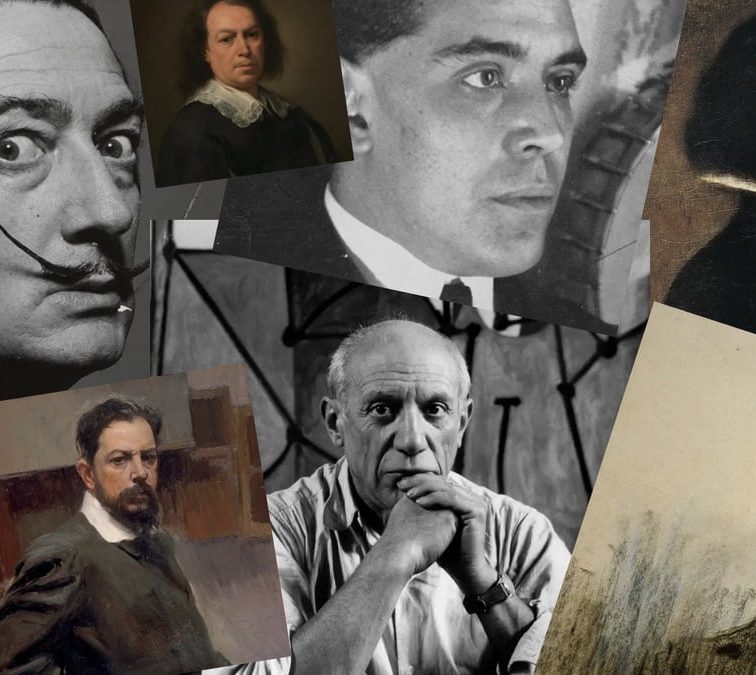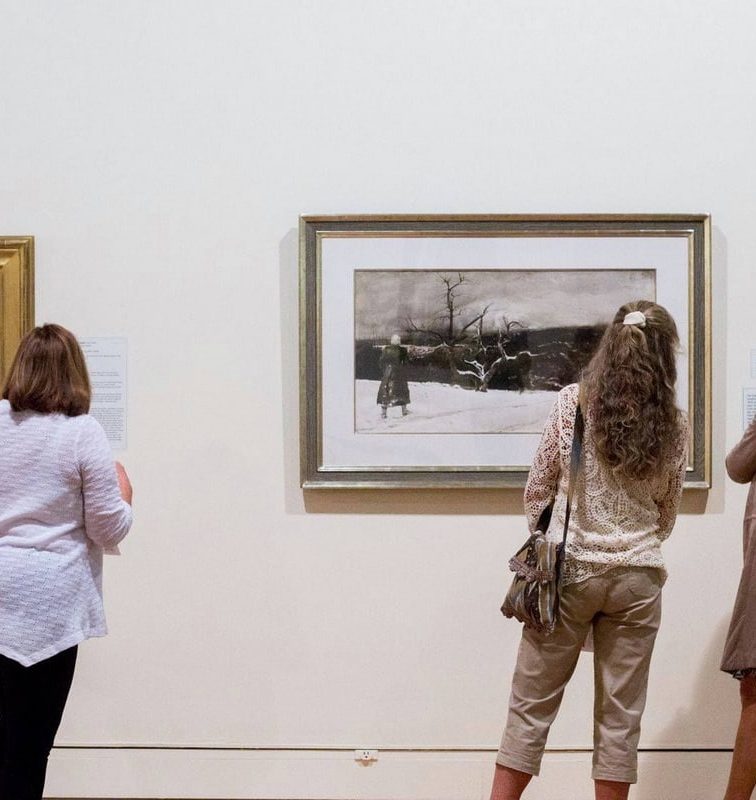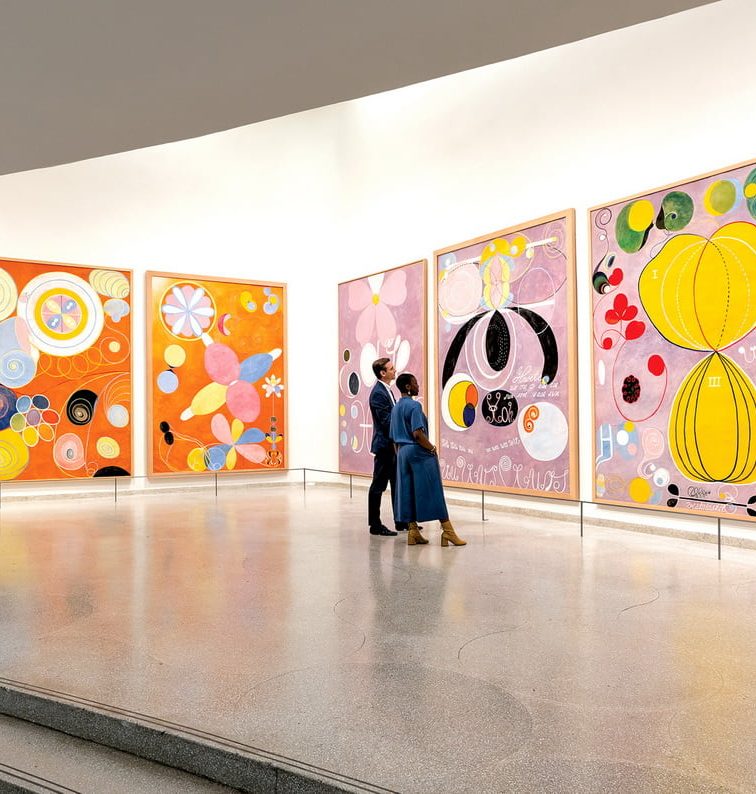Embark on a captivating journey through the luminous world of French painting, where each stroke and hue tells a story of genius and innovation. Imagine the revolutionary brushstrokes of Monet, transforming mundane ponds into ethereal masterpieces, and the daring colors of Matisse, boldly dancing off the canvas.
Uncover the enigmatic charm of Duchamp’s conceptual art and the exotic allure in Gauguin’s works. From the delicate realism of Courbet to the intricate classicism of Ingres, this exploration delves into the lives and legacies of the most famous French artists, whose visions forever altered the landscape of art.
1. Claude Monet: Impressionism’s Pioneer and His Legacy
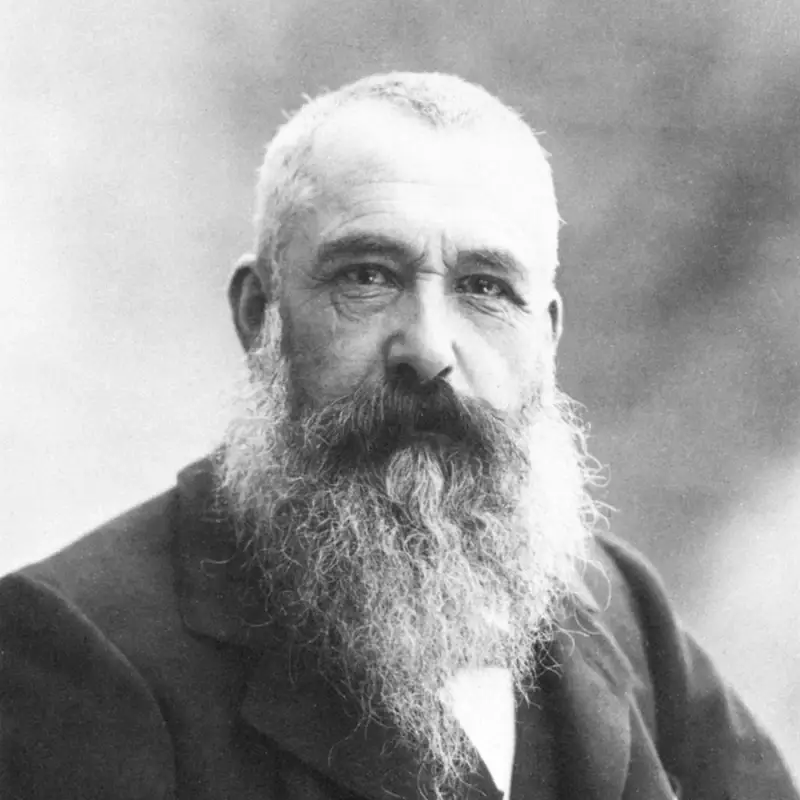
Claude Monet, born in Paris on November 14, 1840, is renowned as a foundational figure in the Impressionist movement. His early life, marked by a move to Normandy, played a pivotal role in shaping his artistic sensibilities. The Normandy coast’s changing weathers and seascapes deeply influenced his artistic vision, nurturing a fresh perspective on nature.
The Evolution of Monet’s Artistic Style
Monet’s artistic journey is characterized by his devotion to plein-air painting, a practice that became synonymous with Impressionism. This approach, involving painting outdoors to capture the immediacy of light and atmosphere, was a radical departure from traditional studio-bound methods. Monet’s relocation to Argenteuil and Vétheuil was significant, offering tranquil landscapes that inspired some of his most iconic works, including series paintings like the Haystacks and Rouen Cathedral, which explored the same subjects under various lighting conditions.
Personal Challenges and Artistic Triumphs
The latter part of Monet’s life was marked by personal challenges, including a battle with cataracts that altered his perception of color and light. Despite these struggles, he continued to innovate, particularly at his residence in Giverny. Here, he created the famous water lily pond, which inspired his celebrated Water Lilies series. These paintings, capturing the essence of his garden and the interplay of light on water, are considered some of his greatest achievements.

Claude Monet, “Water Lilies”, 1917-1919. Image: Wikimedia Commons
Monet’s Enduring Legacy
Monet’s impact on art was profound. His techniques, especially his use of color and brushstrokes, influenced a wide range of artists, from contemporaries like Vincent van Gogh to later movements like Abstract Expressionism. He was a leading advocate for Impressionism, a movement that embraced the depiction of the world through an artist’s immediate impression rather than a detailed representation. His series paintings, particularly “Impression, Sunrise,” which gave Impressionism its name, were instrumental in shaping the movement’s ethos.
Claude Monet passed away on December 5, 1926, in Giverny, leaving behind a legacy that continues to inspire and influence the art world. His works are celebrated globally, showcased in major museums and exhibitions, and continue to captivate audiences with their timeless beauty and innovative spirit.
2. Edgar Degas: Capturing Modern Parisian Life
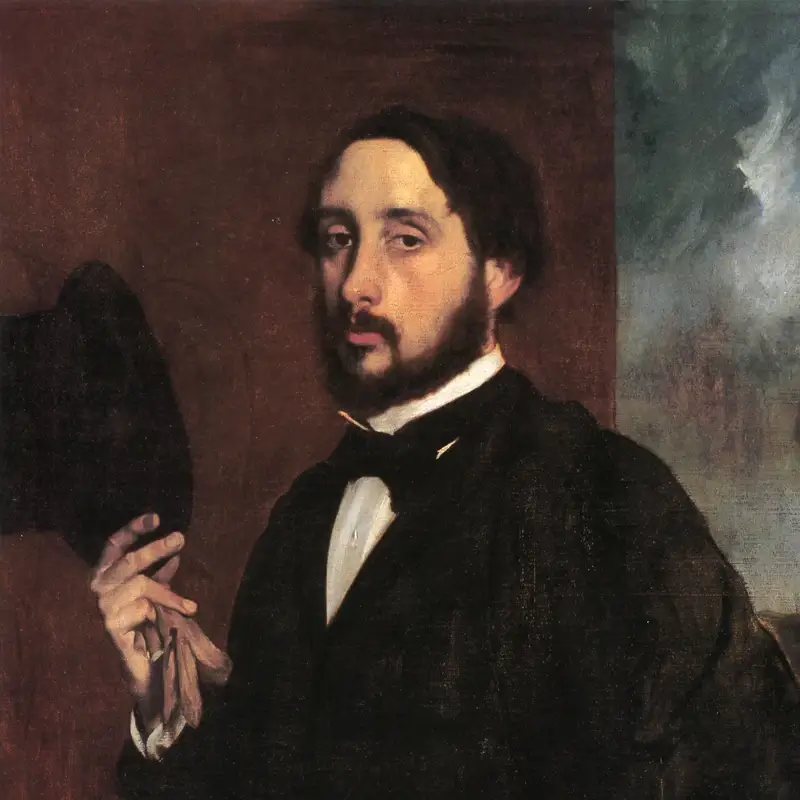
Edgar Degas, born in Paris on July 19, 1834, stands as a towering figure in the Impressionist movement, celebrated for his vivid depictions of Parisian life. Degas’s artistry extended beyond painting to sculpture and printmaking, and he was known for his innovative exploration of various media including oil, pastel, etching, lithography, and photography. His works, ranging from somber portraits to lively studies of ballet dancers, cabaret singers, and scenes of contemporary Parisian society, showcased his remarkable versatility.
The Artist’s Journey and Style Evolution
Degas’s early artistic journey was marked by academic training and a deep respect for the traditional line, heavily influenced by the works of the Renaissance masters and neoclassical artist Jean-Auguste-Dominique Ingres. A significant period of his development occurred during his time in Italy, where he honed his skills by studying and copying the Old Masters.
His return to Paris saw him merge this classical training with more contemporary subjects. Degas’s art often featured unconventional perspectives and compositions, capturing moments of daily life with a striking sense of realism and immediacy. This was particularly evident in his depictions of ballet dancers, a subject he became synonymous with, where he sought to capture the unguarded moments of truth and beauty, often in backstage settings.
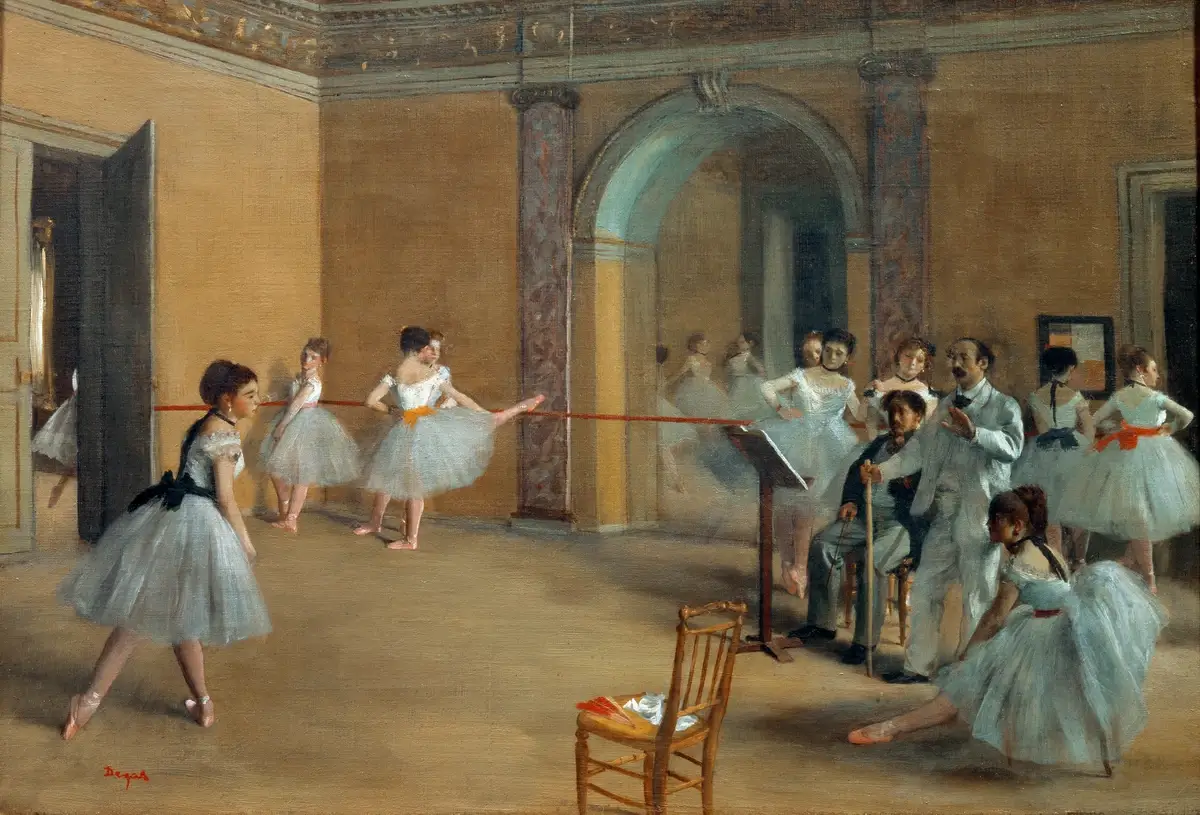
Edgar Degas, “The Dance Foyer at the Opera on the rue Le Peletier”, 1872. Image: Wikimedia Commons
Master of Impressionism and Beyond
Although associated with the Impressionist group, Degas was somewhat of an outsider, often maintaining a distance from the core philosophies of the movement. He preferred the controlled environment of the studio to the plein-air settings favored by many of his contemporaries. His work is noted for its psychological complexity and the exploration of the human figure, often capturing subjects in candid, unposed moments.
The Enduring Legacy of Edgar Degas
Degas passed away on September 27, 1917, but his impact on the art world remains profound. He bridged the gap between traditional academic art and the radical movements of the early 20th century, influencing artists like Pablo Picasso and Henri Matisse. His innovative approach to composition, perspective, and subject matter marked him as one of the most significant and complex figures of his generation.
3. Paul Cézanne: Bridging Impressionism and Cubism
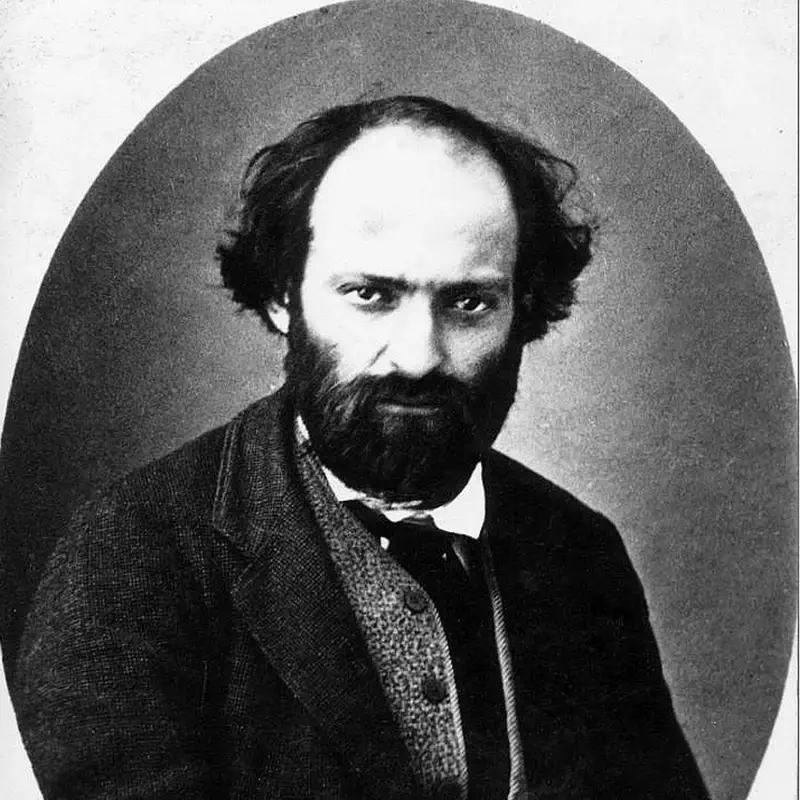
Paul Cézanne, a master of Post-Impressionism, was born on January 19, 1839, in Aix-en-Provence, France. He is renowned for laying the foundation for the transition from 19th-century artistic concepts to a radically different world of art in the 20th century, particularly influencing Cubism. Despite facing public disregard for most of his life, Cézanne’s works challenged the established painting norms of the 19th century, focusing on the painting’s integrity regardless of the subject matter.
Early Life and Artistic Rebellion
Cézanne’s early life was marked by a tense relationship with his father, a wealthy banker, who pushed him towards a career in law. Rejecting his father’s wishes, Cézanne moved to Paris in 1861 with his close friend and future literary giant, Émile Zola. Despite initial rejections from the École des Beaux-Arts, Cézanne’s dedication to art never waned. He frequented the Musée du Louvre, drawing inspiration from masters like Titian and Rubens.
Evolution of Style and Technique
Cézanne’s early works, characterized by dark tones and thick impasto, gradually transformed under the influence of Impressionist Camille Pissarro. After moving to L’Estaque, Cézanne embraced brighter palettes and livelier brushstrokes. His focus shifted from heavy compositions to capturing the vibrancy and light of the Mediterranean landscape. This period marked a significant evolution in his style, where color and form began to take precedence, paving the way for his later masterpieces.
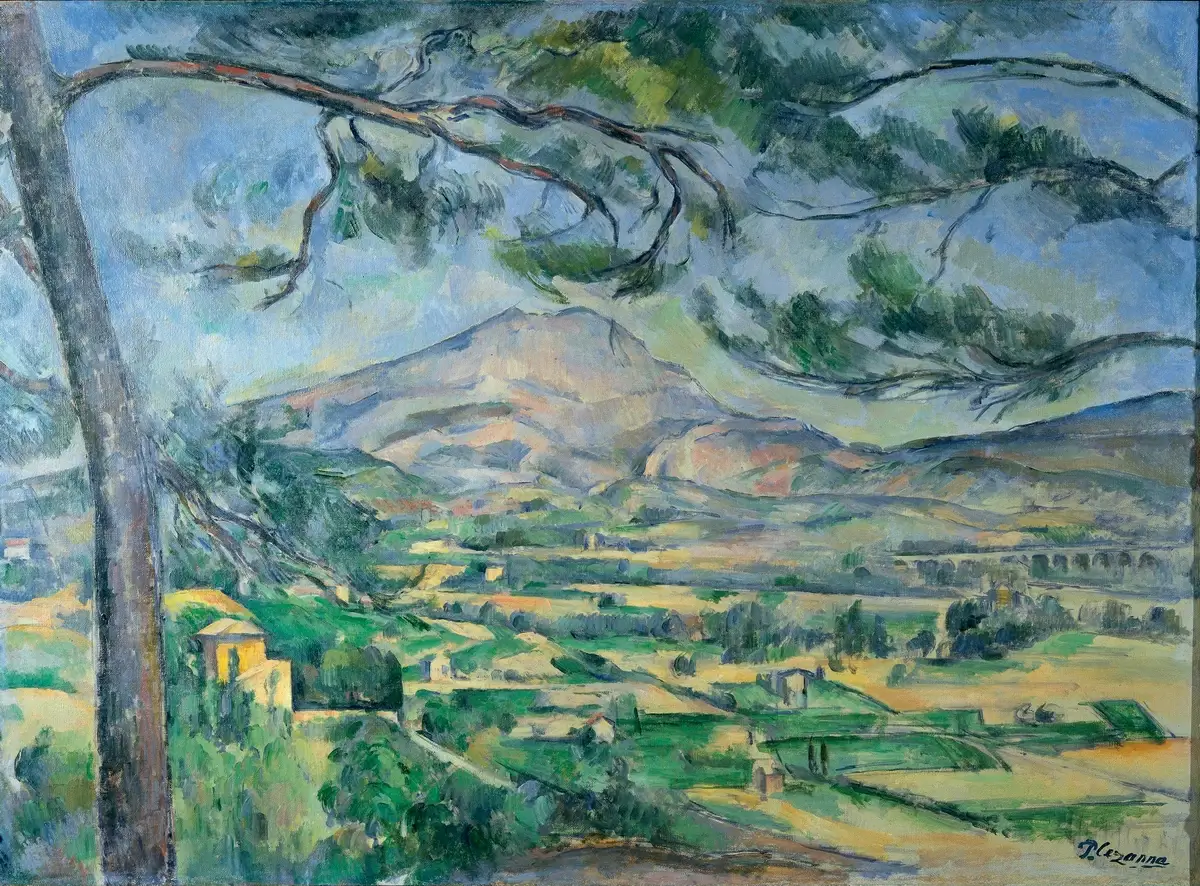
Paul Cézanne, “Mont Sainte-Victoire with Large Pine”, 1887. Image: Wikimedia Commons
Masterpieces and Lasting Influence
Some of Cézanne’s notable works include “Madame Cézanne in a Red Dress,” a portrait that exemplifies his approach of treating human figures almost like still-life objects, and “The Card Players,” reflecting his interest in depicting timelessness. His still-life paintings, like “Table, Napkin, and Fruit,” showcase his unique perspective on ordinary objects. His late works, such as “Study of Trees” and “Mont Sainte-Victoire,” illustrate his move toward abstraction, greatly influencing future modernist movements. “The Large Bathers” is another significant work, blending modern nudes with a natural setting.
Cézanne’s approach to painting, characterized by the equal treatment of color and form and the integration of light within the objects, marked a significant departure from traditional artistry. His works continue to be celebrated for their structural and coloristic innovations.
Paul Cézanne passed away on October 22, 1906, leaving behind a legacy that profoundly influenced the development of modern art, particularly Cubism.
4. Henri Matisse: Innovator of Fauvism and Master of Color
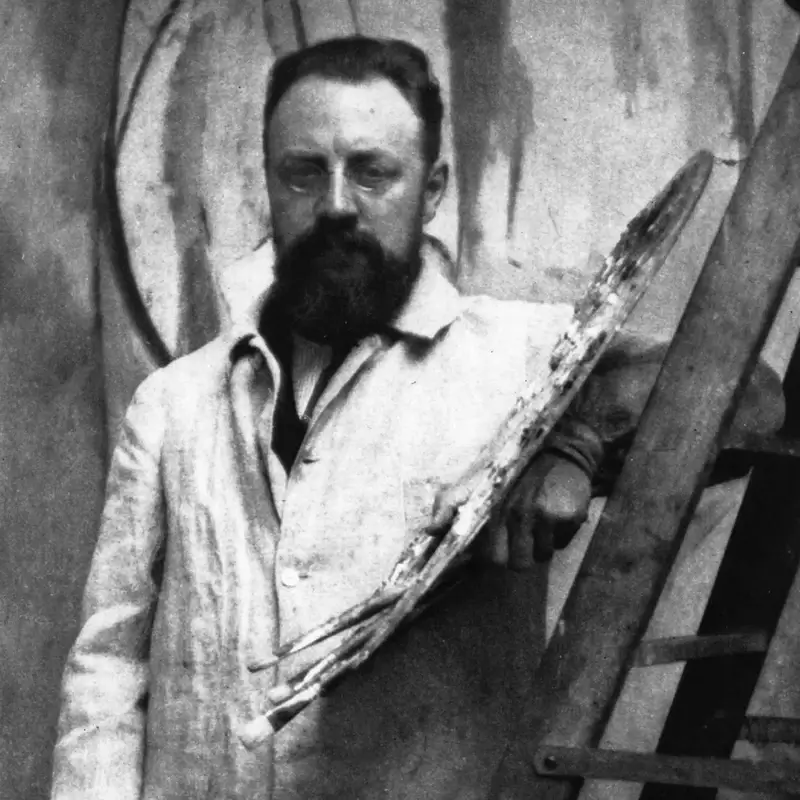
Henri Matisse, born on December 31, 1869, in Le Cateau, Picardy, France, is celebrated as one of the pivotal figures in modern art, especially known for his role in the Fauvist movement and his innovative use of color. His journey into the art world began later than most; it wasn’t until a period of convalescence at age 20 that he discovered his passion for painting.
Early Artistic Development
Initially studying law, Matisse found his true calling in art and moved to Paris in 1891 to pursue his artistic education. Despite failing to gain entry into the École des Beaux-Arts at first, he later joined the studio of symbolist painter Gustave Moreau. Matisse’s early work was influenced by a variety of styles, from academic still lifes to the Impressionists’ loose brushwork.
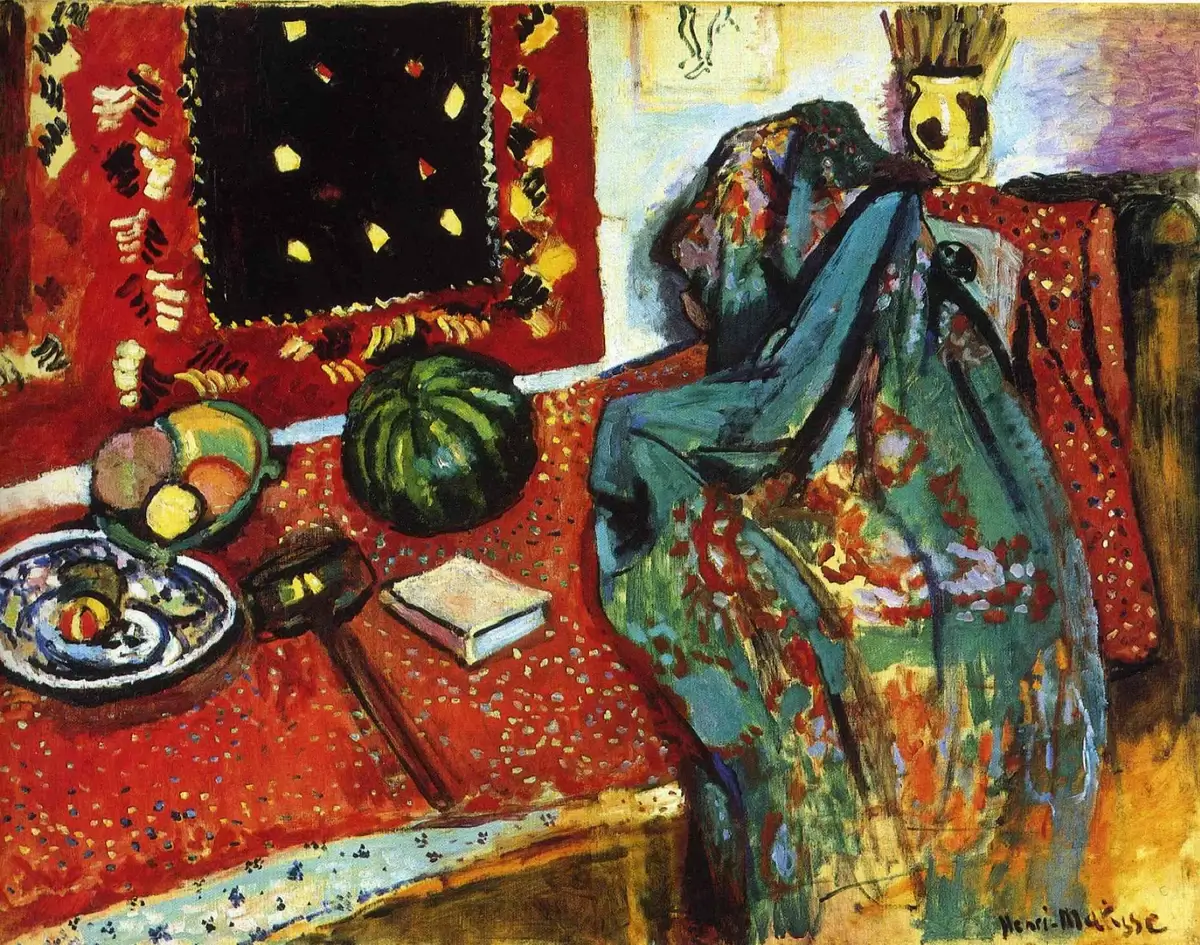
Henri Matisse, “Still life with red Mat”, 1906. Image: arthive.com
Emergence of Fauvism
The year 1905 marked a significant turning point in Matisse’s career. Working alongside André Derain in Collioure, he developed a style characterized by pure, vivid colors and bright light. This new style, dubbed Fauvism (from the French “fauves,” meaning “wild beasts”), was noted for its radical use of color. Matisse, often called the “chief fauve,” emerged as a leader of this movement, which was pivotal in the development of modern art.
Later Works and Influence
Matisse’s later works continued to evolve, moving away from Fauvism towards a more refined exploration of form through color. His friendship and rivalry with Pablo Picasso, whom he met in 1905, represented the diverging paths modern art could take. While Picasso delved into Cubism, Matisse focused on constructing form with color. His innovative approach to painting and his mastery of color theory influenced many subsequent artistic movements.
Matisse’s legacy as an artist extends far beyond his lifetime, with his works continuing to inspire and influence the art world. He passed away on November 3, 1954, in Nice, France, but his impact on the history of modern art remains profound and enduring.
5. Marcel Duchamp: Revolutionizing Art with Readymades
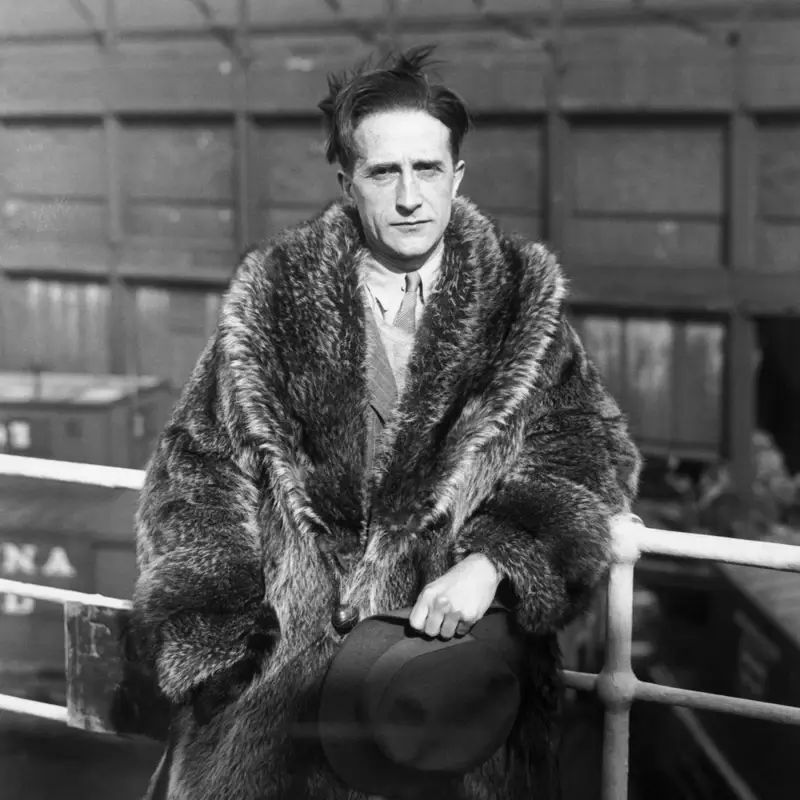
Marcel Duchamp, born on July 28, 1887, in Blainville, France, was a groundbreaking artist who profoundly challenged conventional notions of art in the 20th century. He is widely recognized for his innovative approach that blurred the lines between everyday objects and art, particularly through his creation of “readymades.”
Early Years and Artistic Evolution
Raised in a family with artistic leanings, Duchamp’s early work was influenced by Post-Impressionism, Fauvism, and Cubism. He rapidly moved through these styles, experimenting and exploring new approaches. His most controversial work, “Nude Descending a Staircase (No. 2)” (1912), was a radical departure from traditional art forms, combining Cubist and Futurist principles. The painting caused a sensation for its machine-like representation of motion and its non-traditional approach.
Breakthrough with Readymades
Duchamp’s most significant contribution to art was his concept of the readymade. In 1917, he presented “Fountain,” a porcelain urinal, as a piece of art, challenging preconceived notions about art’s nature and creation. This act was a turning point in the art world, paving the way for future art movements and redefining the boundaries between art and everyday objects. His other famous readymades include “L.H.O.O.Q,” a playful alteration of the Mona Lisa, and “Fresh Widow,” a miniature French window covered in black leather.
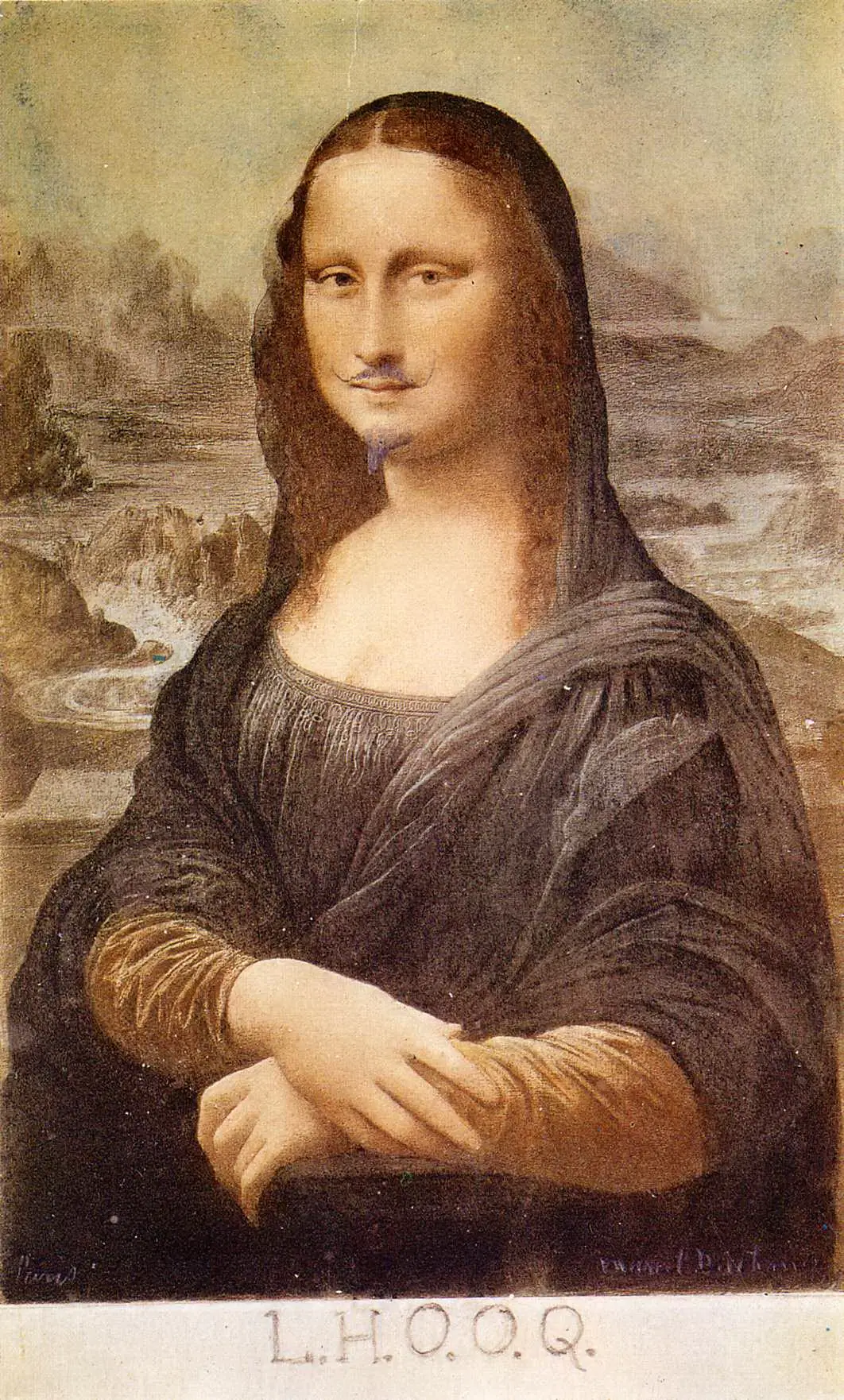
Marcel Duchamp, “L.H.O.O.Q.”, 1919. Image: singulart.com
Legacy and Impact
Duchamp’s work was not just about creating art; it was a philosophical statement questioning the role of the artist and the nature of art itself. His ideas were influential in the development of Dada, Surrealism, and later Conceptual Art. Duchamp’s legacy is that of an artist who dared to challenge the status quo, pushing the boundaries of what art could be and how it could be understood.
6. Paul Gauguin: The Primitivist Post-Impressionist
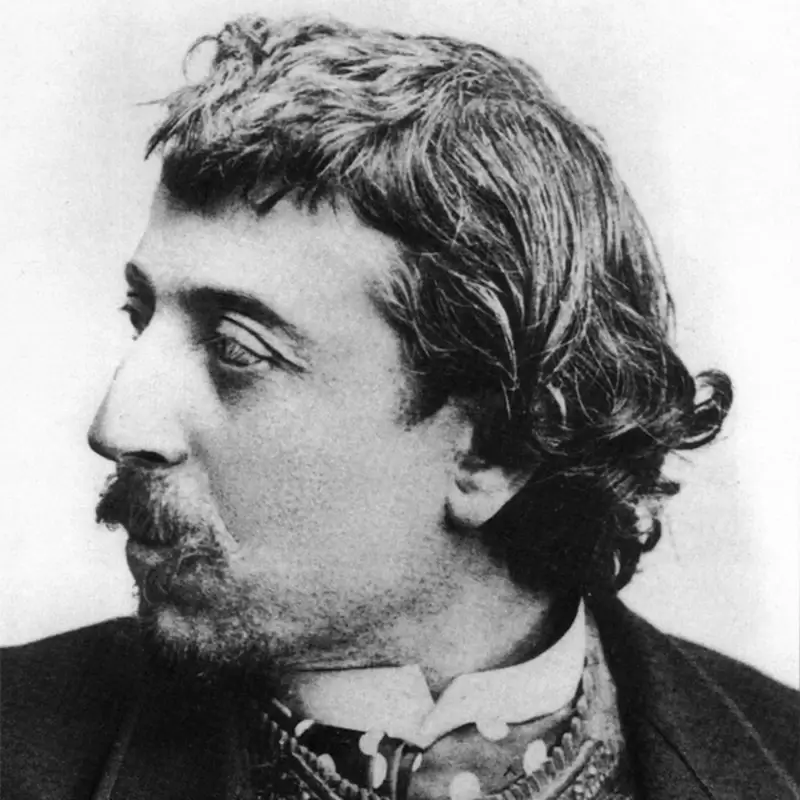
Paul Gauguin, born on June 7, 1848, in Paris, France, was an artist who ventured beyond the conventional and sought a “primitive” expression of spiritual and emotional states. Renowned as a Post-Impressionist, Synthetist, and Symbolist, Gauguin is particularly noted for his creative relationship with Vincent van Gogh and his self-imposed exile in Tahiti, French Polynesia.
Early Life and Artistic Journey
Gauguin’s early life was marked by a mix of cultures and experiences. After his journalist father’s death, he spent four years in Peru, a period that influenced his later artistic work. Returning to France, Gauguin initially worked as a stockbroker and started painting part-time, encouraged by his guardian, Gustave Arosa, and influenced by artists like Camille Corot and Eugène Delacroix. He developed a taste for Impressionism and began assembling a personal collection of paintings by prominent artists such as Édouard Manet and Claude Monet.
Gauguin’s true artistic awakening occurred after the French stock market crash in 1882, which led him to pursue painting full-time. His Impressionist style evolved as he worked alongside artists like Pissarro and Cézanne.

Paul Gauguin, “The Yellow Christ”, 1889. Image: Wikimedia Commons
Artistic Innovations and Tahiti
Gauguin’s move to Tahiti in 1891 marked a significant shift in his art. He sought to escape “everything that is artificial and conventional” and was deeply inspired by the island’s culture, people, and landscapes. His works from this period, such as “Manao Tupapau” and “Where Do We Come From? What Are We? Where Are We Going?”, are celebrated for their bold use of color, strong outlines, and synthesis of the real and the mystical. Gauguin’s art from this period blends the ordinary with the extraordinary, leaving interpretation open to the viewer.
Legacy
Gauguin’s pursuit of an unorthodox lifestyle and his explorations in art had a significant impact on avant-garde developments in the early 20th century. He remained a child of the 19th century while signaling the future of modern art, influencing artists like Pablo Picasso and Henri Matisse. Gauguin’s work continues to be celebrated for its vibrant colors, Symbolist imagery, and integration of different cultural influences.
Gauguin passed away on May 8, 1903, in Atuona, Hiva Oa, Marquesas Islands, French Polynesia. His life and work remain a testament to the power of art to transcend cultural and geographical boundaries.
7. Georges Seurat: Pioneer of Pointillism

Georges Seurat, born on December 2, 1859, in Paris, revolutionized the art world with his innovative technique of Pointillism. Seurat’s approach involved applying tiny, distinct dots of color to the canvas, which, from a distance, visually blend together. This technique was a radical departure from traditional methods of painting and established him as a leader in the Neo-Impressionist movement.
Early Training and Artistic Exploration
Seurat began his formal art education at the École des Beaux-Arts in 1878, studying under the guidance of Henri Lehmann. His early works were influenced by the Impressionist movement, and he was particularly interested in the scientific aspects of color and light, drawing inspiration from color theories by Charles Blanc and Michel-Eugène Chevreul. This led him to explore the chromatic circle of light and experiment with color contrasts and harmony.
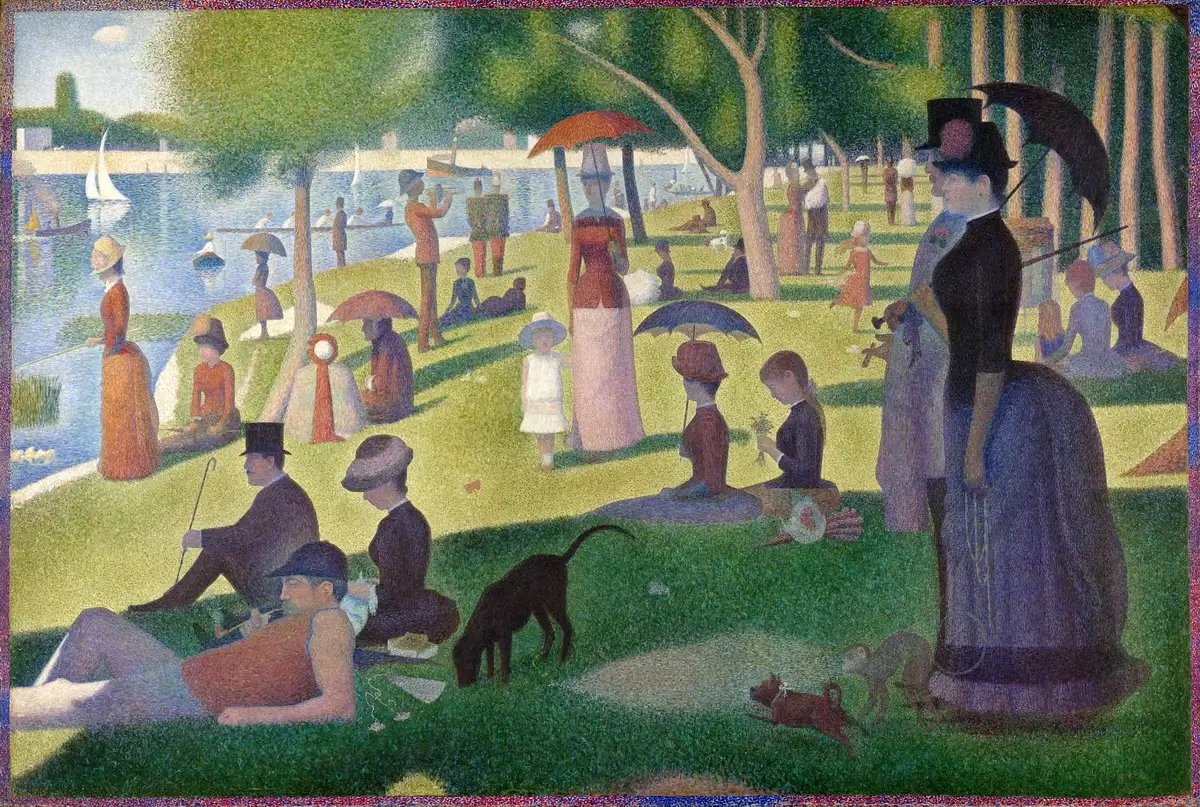
Georges Seurat, “A Sunday on La Grande Jatte”, 1884. Image: Wikimedia Commons
Masterpieces and Legacy
Seurat’s most famous work, “A Sunday on La Grande Jatte—1884,” epitomizes his Pointillism technique. The painstakingly detailed work showcases his mastery of color theory and the optical blending of hues. Seurat’s contribution to art extends beyond his individual works; he laid the foundation for various avant-garde movements in the 20th century. His precise and methodical approach to painting influenced many future artists and movements, including Cubism and Fauvism.
Tragically, Seurat’s career was cut short when he died at the age of 31 in 1891. Despite his brief life, his innovative techniques and artistic vision have left an indelible mark on the history of art.
8. Camille Pissarro: The Essence of Impressionism and Neo-Impressionism
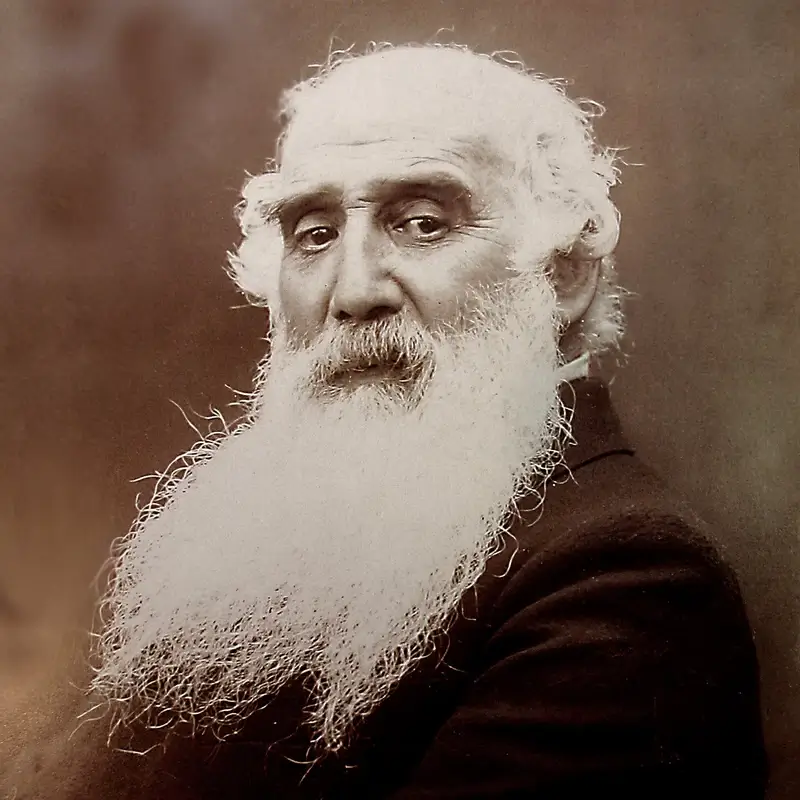
Jacob Abraham Camille Pissarro, born on July 10, 1830, in the Danish West Indies, was a pivotal artist in both Impressionism and Post-Impressionism. His artistic journey began in St. Thomas, where early exposure to art at boarding school in Passy, near Paris, fueled his passion. Despite his family’s expectations to enter the business world, Pissarro’s meeting with Danish artist Fritz Melbye in St. Thomas veered him towards a full-time career in painting.
The Impressionist Movement
Pissarro’s return to Paris in 1855 was a defining moment. He delved into the contemporary art scene, drawing inspiration from masters like Camille Corot, Gustave Courbet, and Jean-François Millet. His early work, influenced by Corot, was marked by rural scenes painted directly from nature. Pissarro was a central figure in the Impressionist movement, being the only artist to exhibit in all eight Impressionist exhibitions. His role was not just as an artist but also as a mentor, guiding figures like Paul Cézanne and Paul Gauguin.
Pioneering Neo-Impressionism
At the age of 54, Pissarro embraced Neo-Impressionism, experimenting with pointillism under the influence of Georges Seurat and Paul Signac. His work from this period, such as “Hoar Frost, the Old Road to Ennery, Pointoise” (1873) and “Hay Harvest at Eragny” (1887), showcases his exploration of color harmony and composition. Pissarro’s approach to Impressionism was characterized by a focus on natural outdoor settings and a deep commitment to painting from direct observation.

Camille Pissarro, “Hoar Frost, the Old Road to Ennery, Pontoise”, 1873. Image: Wikimedia Commons
The Father of Impressionism
Pissarro’s contributions to art extend beyond his paintings. He was a father figure to many Impressionists, influencing not only the style and techniques of the movement but also its philosophy. His emphasis on painting the everyday life of peasants and his dedication to nature and outdoor painting were revolutionary at the time.
Pissarro’s work evolved throughout his career, reflecting his relentless pursuit of artistic growth. He remained active until his death on November 13, 1903, in Paris, leaving behind a legacy that profoundly influenced the development of modern art.
9. Jean-Auguste-Dominique Ingres: The Neoclassical Maestro
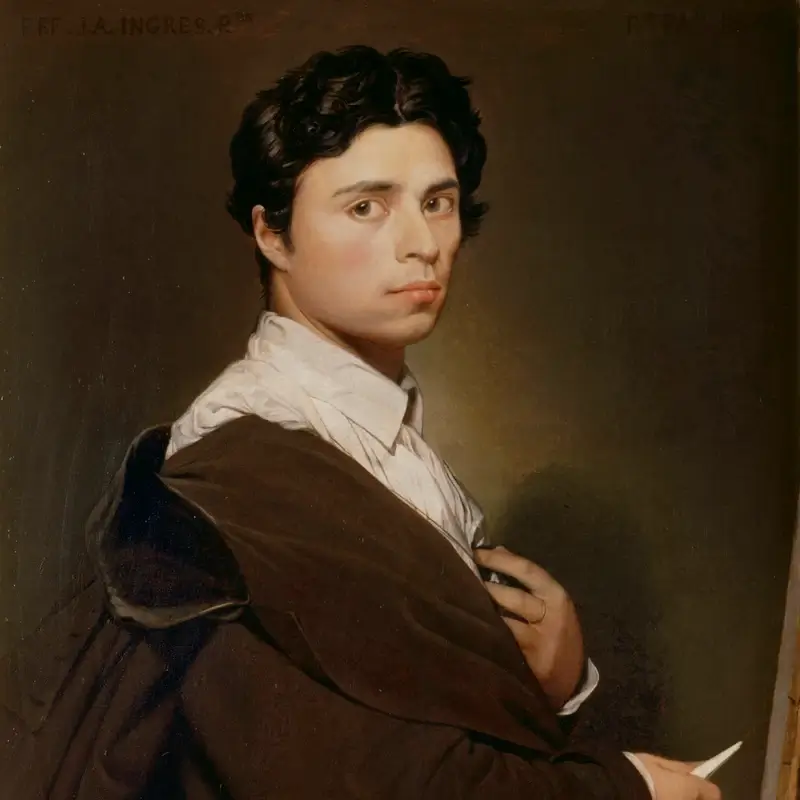
Jean-Auguste-Dominique Ingres, born on August 29, 1780, in Montauban, France, is revered as a towering figure in Neoclassical art. His artistic journey, influenced by the past, especially by the works of Raphael and Nicolas Poussin, led him to become a guardian of academic orthodoxy against the emerging Romantic style.
Formative Years and Artistic Development
Ingres’s early artistic guidance came from his father, Jean-Marie-Joseph Ingres, an artist of modest talent. His formal education was disrupted by the French Revolution, but this didn’t deter him from pursuing art. He later studied under the neoclassical painter Guillaume-Joseph Roques in Toulouse, who instilled in him a deep admiration for Raphael. This period was crucial in shaping his artistic path.
Rising Through the Ranks
Moving to Paris, Ingres studied under Jacques-Louis David, the preeminent French painter of the time. His talent was soon recognized, and he won the prestigious Prix de Rome in 1801 for his painting “The Ambassadors of Agamemnon in the tent of Achilles.” However, due to financial constraints, his stay in Rome was delayed until 1806. During this time, Ingres developed a style emphasizing the purity of contour, inspired by Raphael and Etruscan vase paintings.
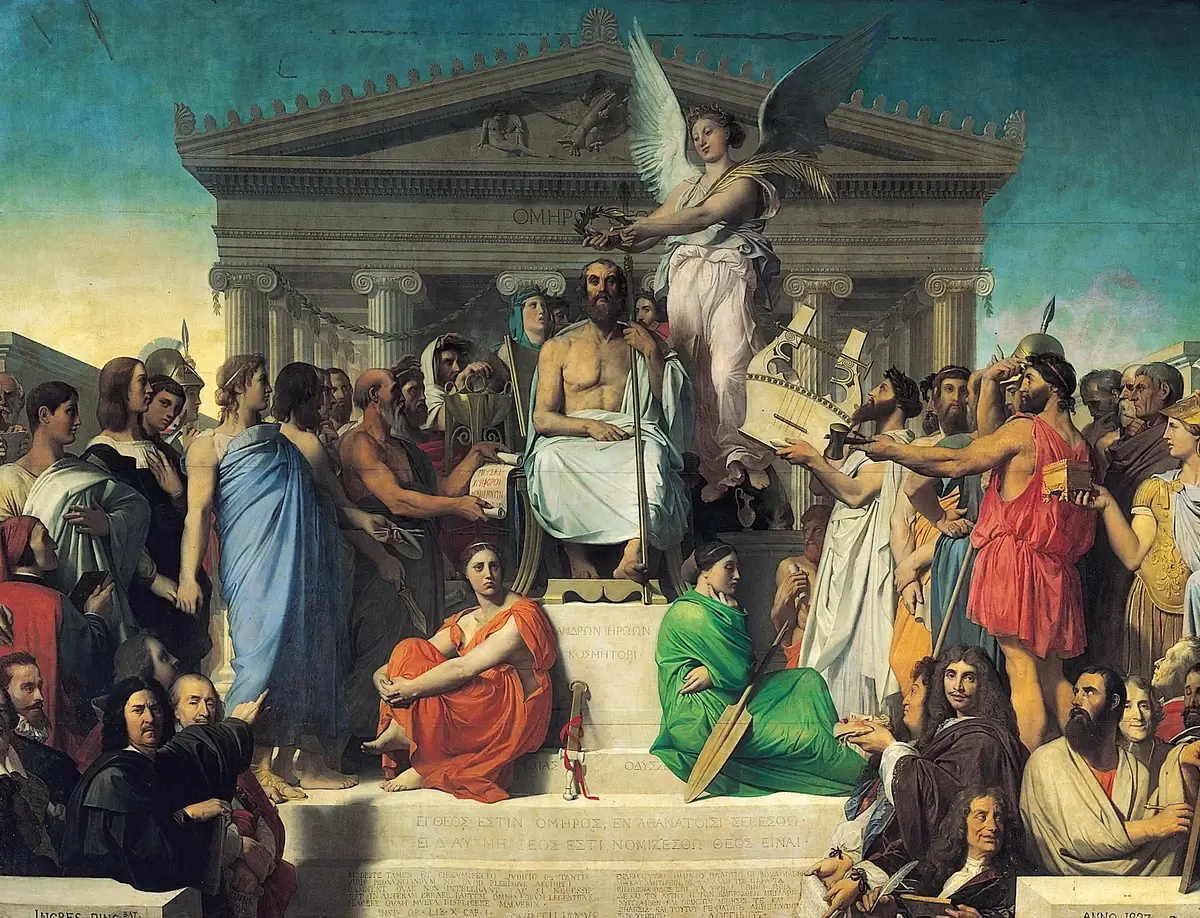
Jean-Auguste-Dominique Ingres, “The Apotheosis of Homer”, 1827. Image: Wikimedia Commons
Triumphs and Controversies
Ingres’s tenure in Rome was marked by continued exploration of neoclassical themes. His work, including “Oedipus and the Sphinx” and “La Grande Odalisque,” often courted controversy for its expressive distortions of form and space, anticipating the formal experiments of 20th-century Modernism. His 1824 painting, “The Vow of Louis XIII,” received critical acclaim at the Salon, affirming his position as a leading Neoclassical artist.
Legacy and Influence
Ingres’s impact on art history is profound. His ability to blend Neoclassical linearity with Romantic sensuality paved the way for future avant-garde movements. His portraits and nudes, marked by expressive distortions, influenced modern artists like Picasso and Matisse. Ingres continued to paint and innovate until his death on January 14, 1867, in Paris, leaving a legacy as one of the key figures in the transition to modern art.
10. Gustave Courbet: The Vanguard of Realism
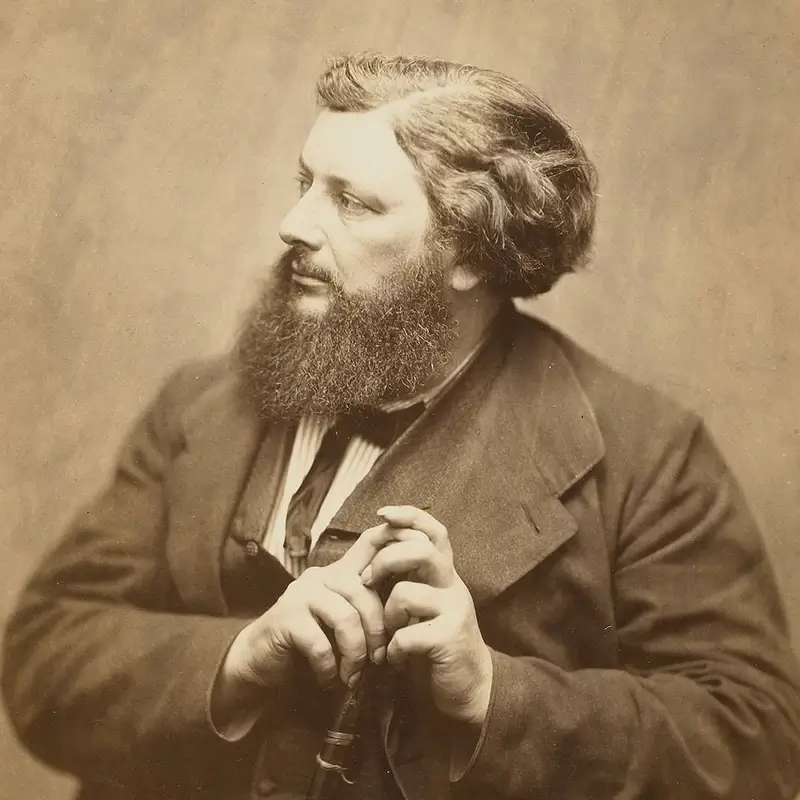
Gustave Courbet, born on June 10, 1819, in Ornans, France, was a revolutionary figure in 19th-century art, pioneering the Realism movement. Defying the Romantic and Neoclassical norms of his time, Courbet chose to portray everyday life and ordinary people in his works. His approach was grounded in depicting the world as he saw it, shunning academic conventions and the idealized visions of previous artists.
Courbet’s Artistic Path
Courbet’s journey into art was one of defiance and self-taught mastery. Eschewing formal art education in Paris, he honed his skills by studying the works of Spanish, Flemish, and French masters in the Louvre. His early works included self-portraits and odalisques, but he soon shifted to realism, drawing inspiration from his surroundings and experiences.
Rise to Prominence
Courbet’s prominence rose with works like “The Stone Breakers” (1849) and “A Burial at Ornans” (1849–1850), which depicted unidealized peasants and workers on a grand scale, a domain traditionally reserved for religious or historical subjects. These paintings challenged societal norms and sparked controversy, laying the groundwork for the Realism movement.
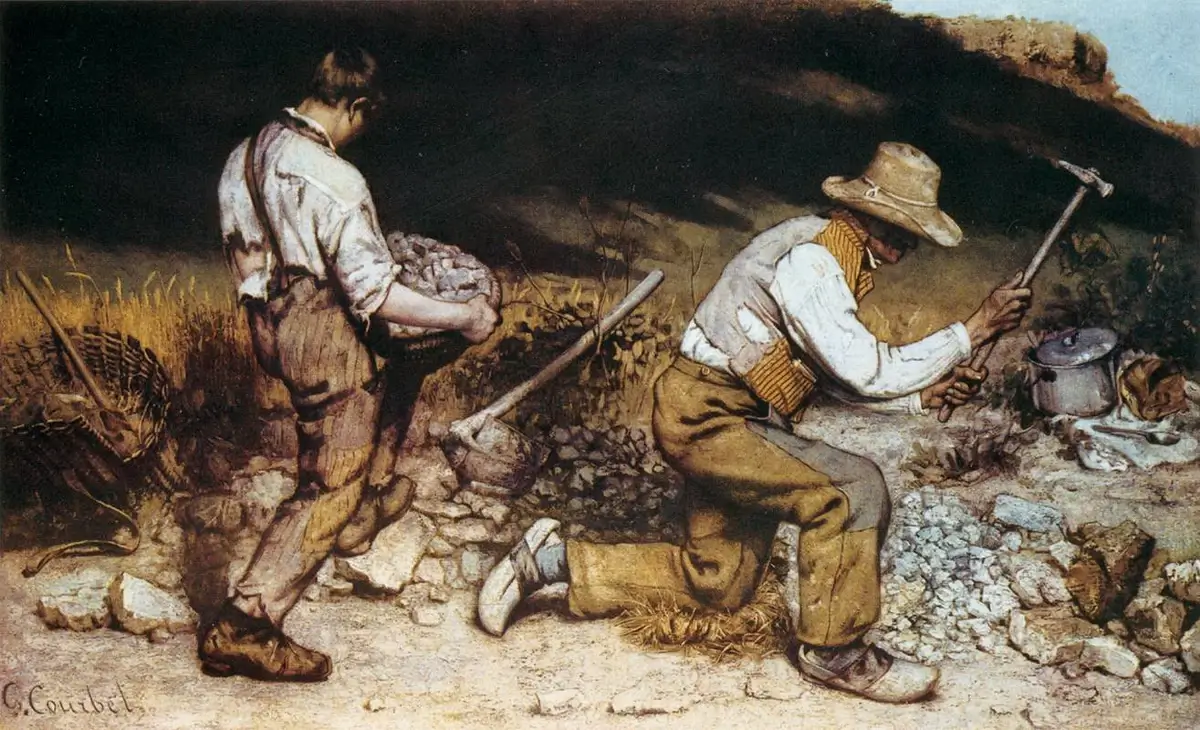
Gustave Courbet, “The Stonebreakers”, 1849. Image: Wikimedia Commons
Courbet and Realism
Courbet’s Realism was not just a style but a social statement, as he often addressed social issues through his works. He believed in painting only what he could see, bringing attention to the lives of the working class. His works like “The Painter’s Studio” (1855) and “L’Origine du monde” (1866) reflect his dedication to portraying the raw truth, often leading to public outcry and criticism.
Legacy and Influence
Courbet’s legacy in the art world is profound. His bold rejection of academic norms and commitment to realism paved the way for future art movements, notably influencing the Impressionists and Cubists. Despite facing opposition and criticism, Courbet remained dedicated to his principles throughout his life, making significant contributions to the evolution of modern art.
11. Édouard Manet: Harbinger of Modern Art
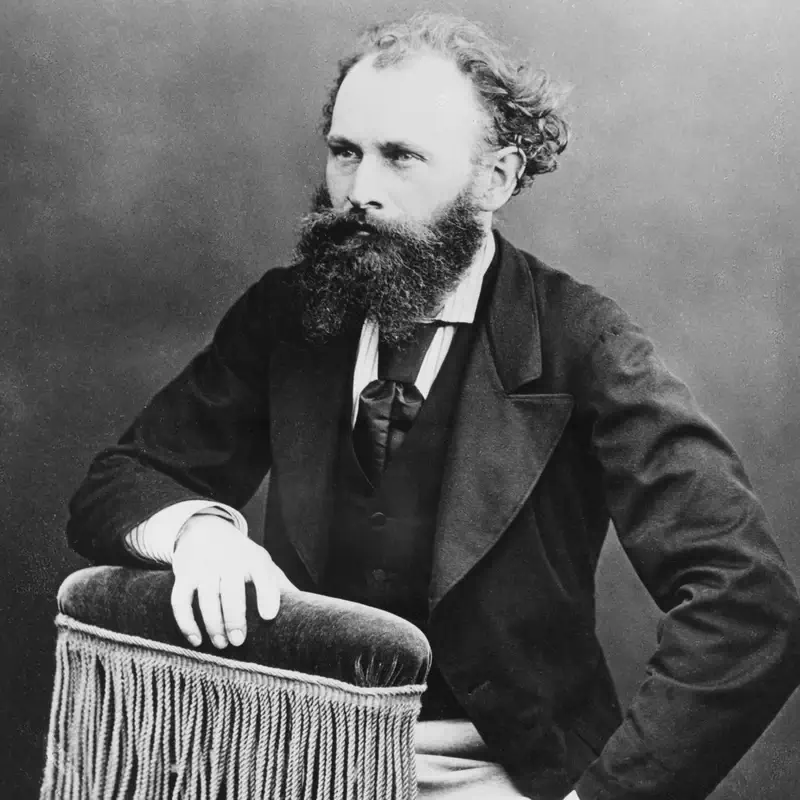
Édouard Manet, born on January 23, 1832, in Paris, emerged as a pivotal figure bridging the gap between Realism and Impressionism. Despite initial aspirations to join the Naval Academy, Manet’s failure to pass the entrance exams redirected his path toward art. His early works, influenced by the old masters he studied in the Louvre, displayed a unique blend of realism and controversy.
The Birth of a Modernist
Manet’s art was marked by a defiance of traditional techniques and subject matters. His paintings like “Le Déjeuner sur l’herbe” (1863) and “Olympia” (1863) broke new ground, both shocking and captivating the Parisian art scene. These works, showcasing modern subjects in a realistic manner, were radical for their time and faced severe criticism for challenging societal norms.
The Salon des Refusés and Manet’s Legacy
Manet’s persistent submissions to the Paris Salon, often rejected due to their unconventional style, led to his participation in the Salon des Refusés. Here, his works gained both notoriety and admiration, particularly among younger artists who would later form the core of the Impressionist group. His final masterpiece, “A Bar at the Folies-Bergere” (1881-82), epitomized his interest in capturing contemporary Parisian life.
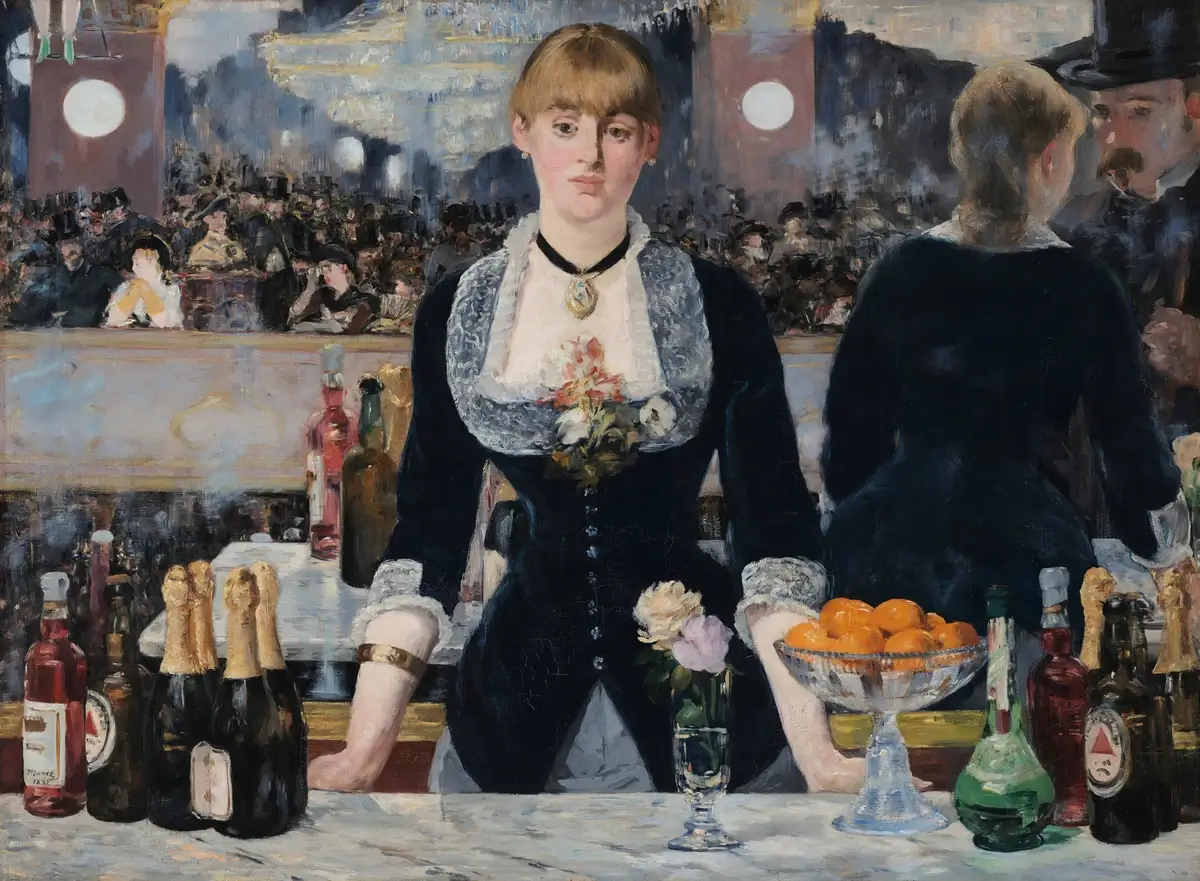
Édouard Manet, “A Bar at the Folies-Bergere”, 1882. Image: Wikimedia Commons
The Godfather of Modernism
Manet’s influence on modern art cannot be overstated. He is often regarded as the first modern artist, pioneering the way for future movements. His integration of realism, bold subject choices, and unconventional techniques marked a significant departure from the romantic and neoclassical styles of his predecessors, influencing artists like Monet and Renoir.
12. Pierre-Auguste Renoir: Impressionism’s Celebrator of Beauty and Light
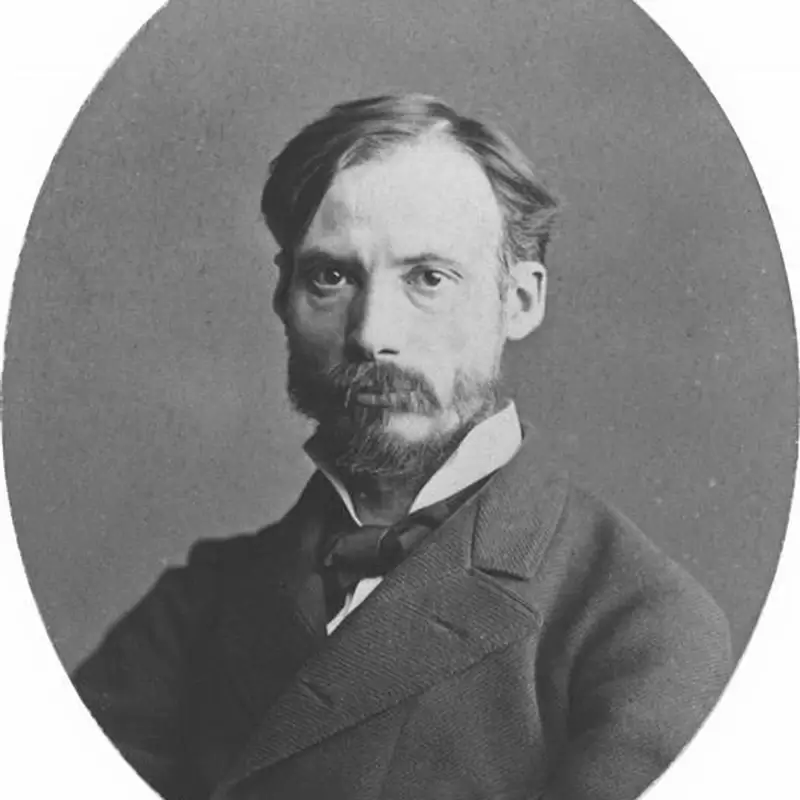
Pierre-Auguste Renoir, born on February 25, 1841, in Limoges, France, rose to prominence as a leading figure in the Impressionist movement. His journey into the art world began at an early age when he worked as a porcelain painter. Recognizing his talent, Renoir’s family supported his decision to pursue formal art training. He studied at the École des Beaux-Arts and in the studio of Charles Gleyre, where he met future Impressionist colleagues, including Alfred Sisley, Frédéric Bazille, and Claude Monet.
Development and Evolution of Style
Renoir’s early works, characterized by their vibrant light and color, captured real-life scenes and were typical of the Impressionist style. However, by the mid-1880s, his style evolved, applying a more disciplined and formal technique, particularly in his portraits and figure paintings. This shift was influenced by his travels to Algeria, Madrid, Italy, and his admiration for the works of Diego Velázquez, Titian, and Raphael.
Contributions to Impressionism
Renoir played a crucial role in the development of Impressionism. He was part of the first Impressionist exhibition in 1874 and continued to showcase his works in subsequent exhibitions. His masterpieces, such as “Dance at Le Moulin de la Galette” and “The Swing,” exemplify the quintessence of the Impressionist movement, with their lively scenes, fluid brushstrokes, and use of light. Despite facing criticism, his works were eventually celebrated, earning him success and recognition.

Pierre-Auguste Renoir, “Dance at Le Moulin de la Galette”, 1876. Image: Wikimedia Commons
Legacy and Influence
Renoir’s portrayal of beauty, particularly feminine sensuality, set him apart in the art world. He continued to paint even in his later years, overcoming the challenges of rheumatoid arthritis. Renoir’s dedication to capturing the joy and beauty of life contributed significantly to the evolution of modern art. He passed away on December 3, 1919, leaving behind a legacy that celebrates the beauty of life through the lens of Impressionism.
13. Yves Klein: The Avant-Garde Visionary of Blue
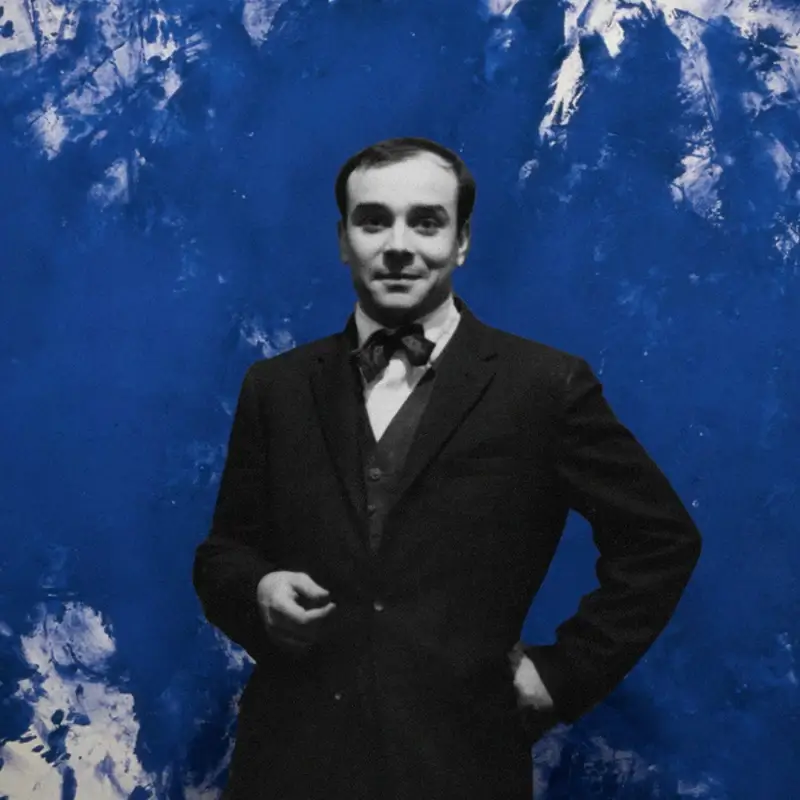
Yves Klein, born on April 28, 1928, in Nice, France, emerged as a revolutionary artist, deeply influencing the Nouveau Réalisme and Performance Art movements. Despite growing up in an artistic family, Klein had no formal artistic training. Instead, his journey was marked by a profound engagement with spiritual and philosophical studies, including Rosicrucianism, which significantly influenced his artistic vision.
Explorations in Judo and Music
Klein’s diverse interests included judo, which he studied intensely in Japan, becoming the first European to achieve a 4th-degree black belt at the Kodokan. His artistic explorations also extended to music, where he composed the Monotone Symphony, a unique piece that consisted of a single sustained chord followed by silence, reflecting his fascination with monochrome and the concept of the void.
The Blue Epoch and Artistic Breakthroughs
Klein’s art is most famously associated with his intense blue monochromes, notably International Klein Blue (IKB), a deep ultramarine which he patented. His Blue Epoch, commencing around 1957, was a period where he produced a series of monochromatic paintings in IKB, representing his quest for immateriality and the infinite. Klein’s innovative use of pure color transcended traditional artistic boundaries, making his work a precursor to minimalism.

Yves Klein, “Anthropometry of the blue period”, 1960. Image: arthive.com
The Void and Anthropometries
In a groundbreaking exhibition titled “The Void” in 1958, Klein presented an empty gallery, challenging the conventional notions of art and space. He further expanded his artistic repertoire with the Anthropometries series, where he used nude female models as ‘living brushes’ to apply paint, creating works that were both performance and painting.
Legacy and Influence
Yves Klein’s short yet impactful career ended with his untimely death at the age of 34 in 1962. However, his work left an indelible mark on the art world. Klein’s radical approaches, particularly his use of color, conceptual gestures, and performance art, laid the groundwork for much of the contemporary art that followed.
14. Nicolas Poussin: Master of French Baroque and Classical Art
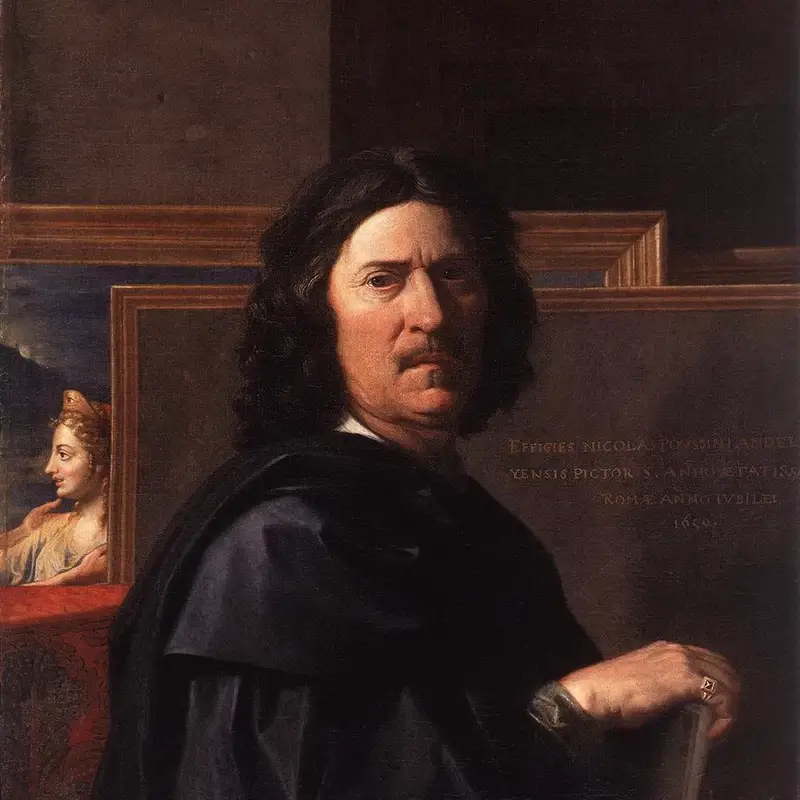
Nicolas Poussin, born in June 1594 in Les Andelys, Normandy, is celebrated as a pivotal figure in the French Classical tradition. His journey into art began with early training under local painter Quentin Varin in Normandy. In pursuit of a broader artistic education, Poussin relocated to Paris around 1612. Here, he was exposed to the works of Italian Renaissance masters, notably Raphael, whose influence would become a defining element in Poussin’s style.
Rome: The Crucible of Poussin’s Art
Poussin’s artistic destiny was largely shaped by his time in Rome, where he moved in 1624. In Rome, he deeply immersed himself in studying classical art and Renaissance works, particularly those of Raphael. His mastery began to flourish, crafting history paintings rich in narrative clarity and dramatic force. Works like “The Death of Germanicus” and “The Massacre of the Innocents” exemplify his skill in handling religious and mythological subjects.
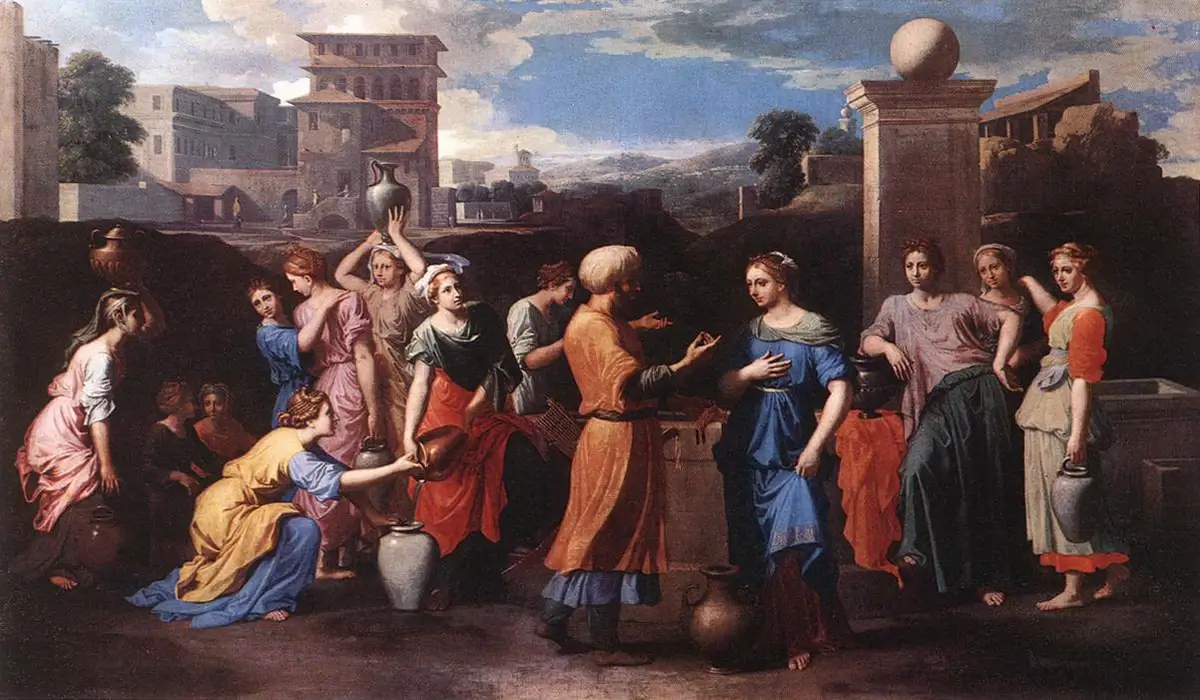
Nicolas Poussin, “Rebecca at the Well”, 1648. Image: Wikimedia Commons
Evolution of Style and Major Works
Poussin’s style evolved over the years, showing a transition from the sensuality and coloristic richness of his early works to a more disciplined and idealized manner. This shift mirrored his reverence for classical art. Among his notable works are “Eliezer and Rebecca” and “The Adoration of the Magi,” showcasing his penchant for narrative detail and compositional harmony. In his later years, Poussin’s focus expanded to include landscapes, exemplified in works like “Landscape with Hercules and Cacus,” imbuing them with allegorical and pantheistic elements.
Legacy and Revival of Interest
Poussin’s contribution to art history extends beyond his lifetime. Initially, his reputation dwindled in the early 18th century but saw a spectacular revival during the Neoclassical movement, particularly influencing artists like Jacques-Louis David. His emphasis on classical harmony, order, and discipline in art made him a central figure in the evolution of French art.
15. Jean-Honoré Fragonard: The Rococo Enchanter
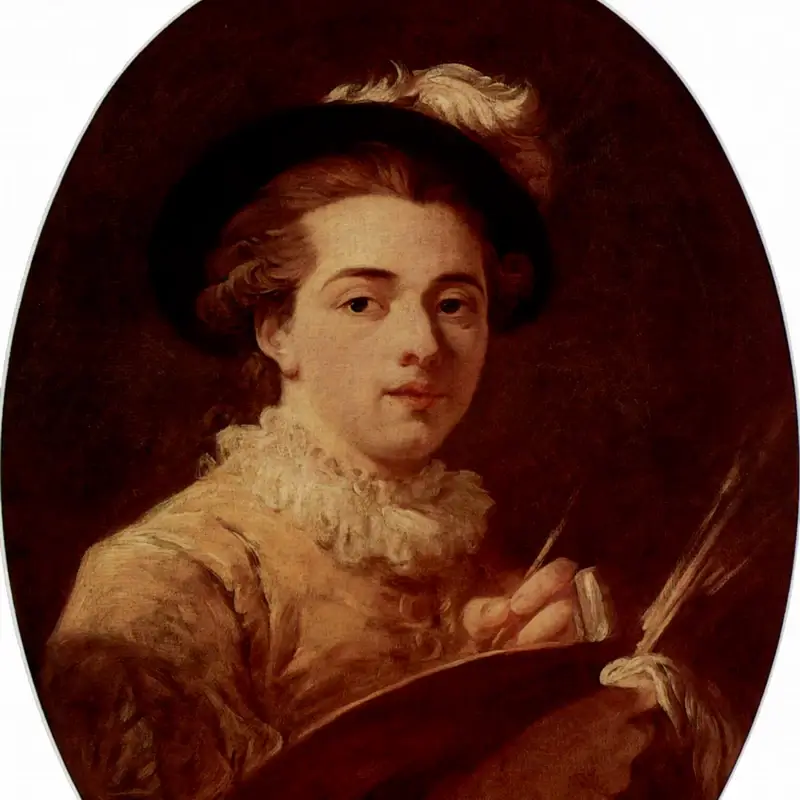
Jean-Honoré Fragonard, born on April 5, 1732, in Grasse, France, rose to become a central figure of the Rococo art movement. Despite his humble beginnings as the son of a haberdasher’s assistant, Fragonard’s undeniable talent for drawing led him to Paris, where he was apprenticed to a lawyer. However, his passion for art prevailed, and he soon found himself under the tutelage of François Boucher, a leading Rococo painter.
The Path to Artistic Success
Fragonard’s artistic prowess quickly earned him the prestigious Prix de Rome in 1752, paving the way for his studies at the French Academy in Rome. His time in Italy was transformative, as he absorbed the influences of Baroque masters and the sumptuous style of Giovanni Battista Tiepolo. His return to Paris in 1761 marked the beginning of his most productive phase, where he created works that epitomized the Rococo spirit – characterized by playful, sensual, and often erotic themes.
Signature Works and Themes
Fragonard’s works are celebrated for their delicate hedonism and fluid painting style. “The Swing” (1767) remains one of his most iconic works, capturing the frivolity and sensuous pleasure of the Rococo era. His other notable paintings include “Coresus et Callirhoe,” which secured his admission to the Academy, and “The Progress of Love” series. These works display his mastery in portraying love and voluptuousness, balancing tender beauty with virtuosity.

Jean-Honoré Fragonard, “The Swing”, 1767. Image: Wikimedia Commons
The Turn of the Tide
Despite his success, the French Revolution’s upheaval led to a decline in Fragonard’s private commissions. He shifted towards Neoclassicism in response to changing tastes, but eventually retreated from Paris, spending his later years in relative obscurity.
Legacy
Fragonard passed away on August 22, 1806, in Paris. His contribution to the Rococo style significantly influenced the later Impressionist movement. Today, Fragonard is remembered as a master of French painting, whose works encapsulate the essence of an era.
16. Jean Fouquet: French Pioneer of the Early Renaissance
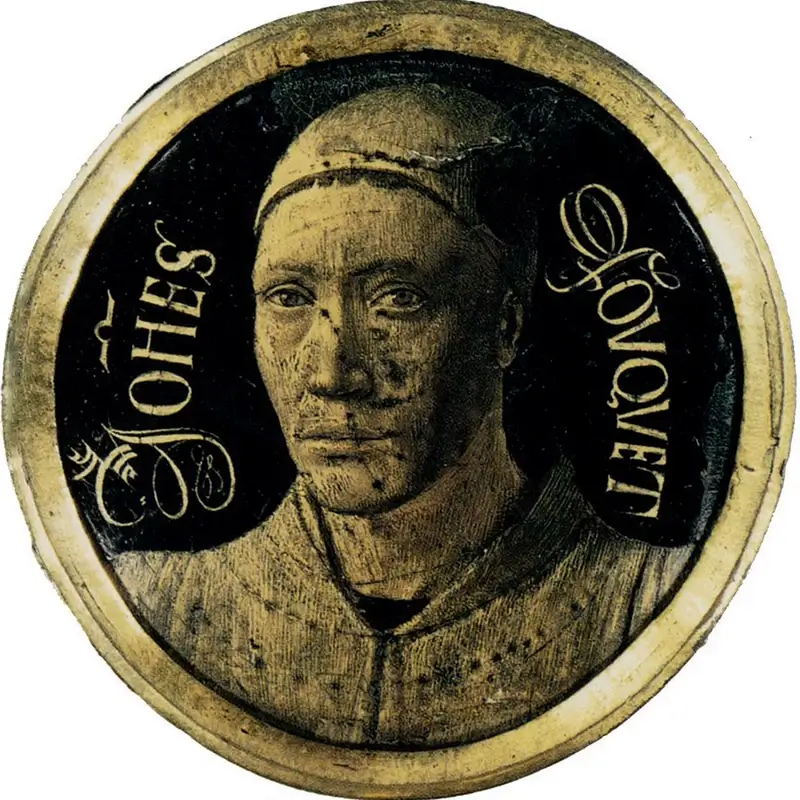
Jean Fouquet, born circa 1420 in Tours, France, is celebrated as a pivotal figure in early French Renaissance art. Known for his mastery in panel painting and manuscript illumination, he was notably the first French artist to experience the Italian Renaissance firsthand, profoundly influencing his artistic style.
Italian Influence and Courtly Commissions
Fouquet’s journey to Italy around 1445-1447 exposed him to Roman Quattrocento artists like Fra Angelico and Filarete, shaping his unique style. Back in France, he worked for the French court, including kings Charles VII and Louis XI, integrating elements of the Tuscan style with influences from the Van Eycks.
Signature Works and Artistic Style
Fouquet’s excellence in detail and character portrayal is evident in works like the Melun Diptych, where he blends French art with Italian influences. His illuminated manuscripts, including the Hours of Étienne Chevalier, showcase his precision and clarity in miniature scale, establishing him as a significant figure in French art.
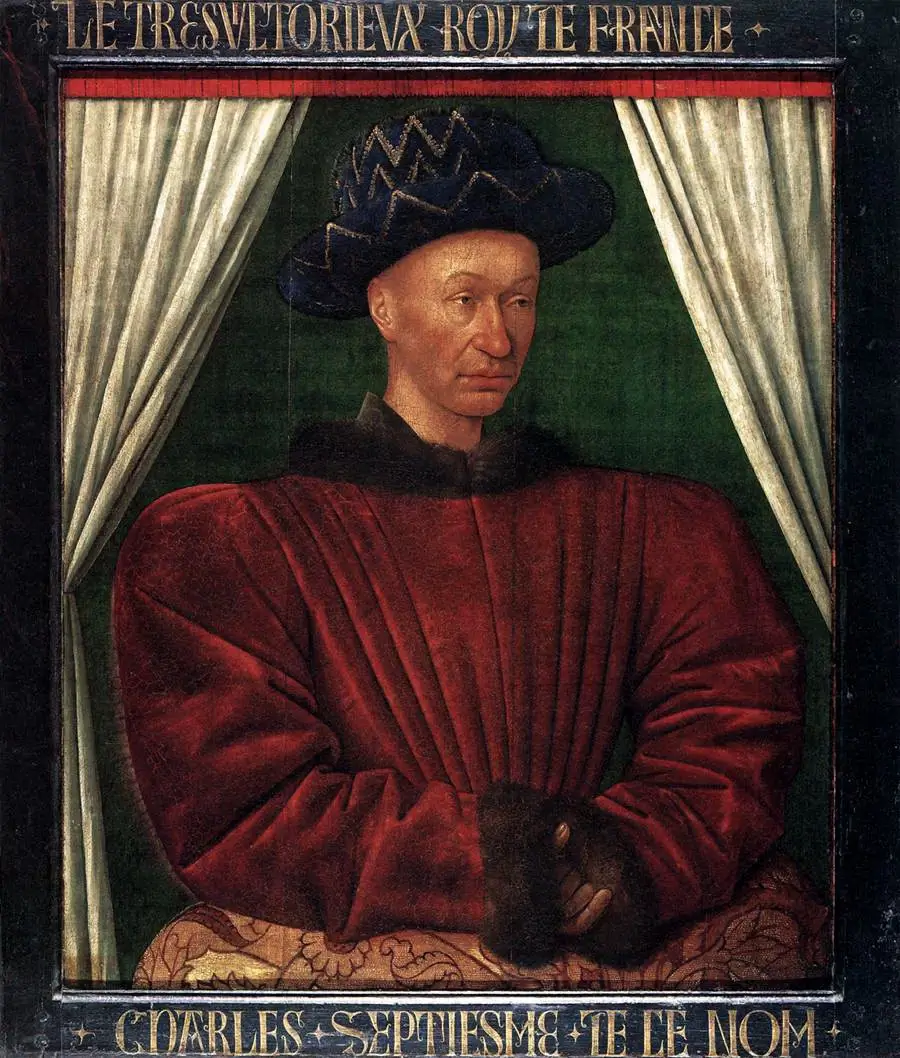
Jean Fouquet, “Portrait of Charles VII of France”, 1445-1450. Image: Wikimedia Commons
Legacy
Fouquet’s blending of French and Italian elements laid the foundation for 15th-century French art, making him a founder of a new school in French art history.
FAQ
Who was the most famous artist in France?
Claude Monet is often regarded as one of the most famous artists in France. He was a founder of French Impressionist painting, and his approach to art, especially his landscape painting, has had a profound impact on the art world.
Who is the most famous French modern artist?
Henri Matisse is considered one of the most famous French modern artists. Known for his use of color and original draughtsmanship, he was a leading figure in modern art and a major influence on 20th-century art.
Who is the French artist famous for his famous style?
Georges Seurat is renowned for his unique style known as Pointillism. He developed this technique, involving painting with small, distinct dots of color that, when seen together, create an image.
Who is a French artist who is famous still life?
Paul Cézanne is a famous French artist known for his still life paintings. He created numerous still life works that are celebrated for their unique perspective and complex composition.






